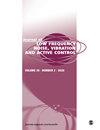基于reynolds -average Navier-Stokes和线性化Navier-Stokes方程的甲烷燃烧热声系统声学分离分析
IF 2.4
4区 工程技术
Q1 ACOUSTICS
Journal of Low Frequency Noise Vibration and Active Control
Pub Date : 2023-05-17
DOI:10.1177/14613484231174860
引用次数: 1
摘要
为了从时空频耦合的角度研究不同流速和不同甲烷质量分数下的声激励和衰减效应,建立了reynolds -average Navier-Stokes (RANS)方法和线性化Navier-Stokes方程的耦合模型。结果表明,在高频声激励下,声模态的能量分布更为均匀。多耦合物理场下的声振荡幅值比简单流场下的声振荡幅值高10000倍。当wch = 0.8时,基频信号向高频信号的能量转换比例最大,燃烧室系统向外传输波的比例最大,非线性效应最强。当wc4h增大时,各点的振荡幅度和高频信号沿轴向的衰减作用增强。在Uin = 15 m/s的情况下,谐波幅值比其他情况降低了18%,而高频谐波的比例增加,证明了这种情况下的非线性是不可忽视的。随着速度的增加,基频信号向高频信号的能量转换增强;越靠近出口位置,振荡信号越复杂。模型形状分析表明,当w C H 4 = 0.8时,燃烧器下游二次谐波幅值最大,而在燃烧器末端Uin = 15 m/s时,二次谐波幅值迅速增大,进一步说明低频信号向高频信号的能量转换主要发生在中下游区域。本文章由计算机程序翻译,如有差异,请以英文原文为准。
Analysis of separating acoustics from the thermoacoustic system of methane combustion based on Reynolds-averaged Navier-Stokes and linearized Navier-Stokes equations
A model coupling Reynolds-averaged Navier-Stokes (RANS) method and linearized Navier-Stokes equations (LNSEs) was established in order to investigate the acoustic excitation and attenuation effect from a coupling perspective of time–space–frequency under various flow velocities and mass fractions of methane. Results show that the energy distribution of acoustic modes under high-frequency acoustic excitation is more uniform. The amplitude of the acoustic oscillation at a multiple coupling physical field is 10,000 times higher than that at simple flow field. The case when w C H 4 = 0.8 owns the largest percentage of energy conversion from fundamental to high-frequency signals, the largest percentage of transmitted waves from the combustion chamber system to outside and the strongest non-linear effect. When w C H 4 rises, the amplitude of oscillations at points and the attenuation effect of high-frequency signals along the axial are enhanced. At the case of Uin = 15 m/s, the amplitude of harmonics is reduced by 18% compared with other cases, while the proportion of the high-frequency harmonic increases, proving the non-linearity cannot be neglected in this case. As velocity rises, the energy conversion from fundamental to high-frequency signals enhances; while closer to the outlet position, the more complex the oscillation signal is. Model-shapes analysis shows that a case of w C H 4 = 0.8 owns the largest amplitude of the second harmonic at downstream of the burner, while the amplitude of the harmonics rapidly increases at Uin = 15 m/s at the end of the burner, which further indicates that the energy conversion of low-frequency signals to high-frequency signals occurs mainly in the middle and downstream regions.
求助全文
通过发布文献求助,成功后即可免费获取论文全文。
去求助
来源期刊

Journal of Low Frequency Noise Vibration and Active Control
Engineering-Mechanical Engineering
CiteScore
4.90
自引率
4.30%
发文量
98
审稿时长
15 weeks
期刊介绍:
Journal of Low Frequency Noise, Vibration & Active Control is a peer-reviewed, open access journal, bringing together material which otherwise would be scattered. The journal is the cornerstone of the creation of a unified corpus of knowledge on the subject.
 求助内容:
求助内容: 应助结果提醒方式:
应助结果提醒方式:


